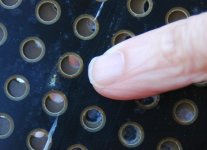Thanks for posting the very interesting photos of the 2SW lens pattern. The cross sectional diagram I posted earlier is different than Bev's but deliberately so. I wanted to limit distribution to 120-140 degrees instead of 180 degrees. Also, not shown on the picture, I divided the center portion into two 15 degree lateral channels instead of having sound coming strait out. I didn't see the need to have the speakers firing sound at each other but instead directed it at the listening area. Using a lens does make the ESL panel less efficient but I am still able to drive it very well with a 60 watt amplifier electronically crossed over at 500HZ. Frank's contention that direct drive amplifiers are superior to a transformer coupled drive is possibly true, but my technical skills unfortunately don't include designing amplifiers and I have never been able to hear a direct comparison between the two methods. ESL speakers I have heard or lived with have had either system but each design was different enough that none of them sounded the same and any conclusions about about the amplification was confused by other issues. Regards,
Ted
Ted
Hello.
Do conductive pattern material of Beveridge PCB type stators is known?
Is it:
carbon compaund on glass fiber
carbon compaund on glass fiber and carbon covered with nylon layer
carbon compound on copper layer on glass fiber
carbon compaund on copper layer on glass fiber and carbon covered with nylon layer ?
And possibly variant of carbon as carbon nylon compound with distributed resistivity without need of clear nylon layer.
And what surface resistiviry carbon layer have?
(The photo from RMS).
Do conductive pattern material of Beveridge PCB type stators is known?
Is it:
carbon compaund on glass fiber
carbon compaund on glass fiber and carbon covered with nylon layer
carbon compound on copper layer on glass fiber
carbon compaund on copper layer on glass fiber and carbon covered with nylon layer ?
And possibly variant of carbon as carbon nylon compound with distributed resistivity without need of clear nylon layer.
And what surface resistiviry carbon layer have?
(The photo from RMS).
Attachments
Last edited:
Hello.
Do conductive pattern material of Beveridge PCB type stators is known?
Is it:
carbon compaund on glass fiber
carbon compaund on glass fiber and carbon covered with nylon layer
carbon compound on copper layer on glass fiber
carbon compaund on copper layer on glass fiber and carbon covered with nylon layer ?
And possibly variant of carbon as carbon nylon compound with distributed resistivity without need of clear nylon layer.
And what surface resistiviry carbon layer have?
(The photo from RMS).
Hello,
I don't know the answers to your questions since I haven't owned Beveridge speakers for several decades.
The best place to get the answer to your questions is probably from Rick Beveridge. Beveridge audio still has a website you can access directly.
